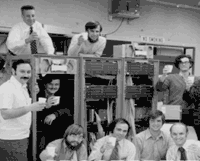 |
|||
 |
|||
Larry Roberts finished writing the
Request for Proposals and sent it to 140 potential contractors in the summer
of
1968. After a few months, about twelve
came back to ARPA, including BBN's proposal. Two of the largest computer
companies, IBM and Control Data Corporation (CDC), declined to make a bid,
confident that packet-switching was an unworthy endeavor.
Roberts cut the number he considered appropriate down to four, including
BBN and
Raytheon. Raytheon looked like the early leader
in the competition for the contract. They had more resources than BBN and
they claimed they could make the network faster than the proposal required.
However, BBN made the same claim and they supplied the details on how they
were going to do it. BBN had spent several months and over $100,000 writing
the proposal and Roberts felt BBN's proposal was a better plan.
BBN received word that they won the contract, and they were congratulated
via telegram by Massachusetts' Senator Edward Kennedy for the winning the
On the first day of 1969,
Frank Heart collected his team together and
started working on designing and programming the IMP. They chose the
Honeywell DDP-516 for the computer they would modify into the IMP. The
DDP-516 was one of the most powerful minicomputers on the market, and Heart
liked it because it was built to military specifications - reinforced
body and i-bolts on top.
The team's primary members included programmers
Will Crowther and
Dave Walden, BBN's star debugger
Bernie Cosell, and
Severo Ornstein,
the geologist turned computer hardware specialist.
Bob Kahn volunteered to
write a specification to send to the participating centers detailing how
to connect their computers to the IMP. They had about eight months
to deliver the first IMP to UCLA on Labor Day.
When the first modified IMP (IMP-0) was delivered to BBN, Ben Barker
(the young engineer assigned to testing it) discovered that the modifications
were all wrong. In the 1960's changing the computer's configuration meant
unwrapping and wrapping hundreds of tight bundles of wires. Barker spent a
few months of long days reconfiguring the Honeywell.
IMP-1 was delivered to BBN just two weeks before Labor Day. They had sent
instructions on the changes Barker made to the first IMP to Honeywell and
they expected everything to work this time. However, when Barker powered
the Honeywell up, nothing worked. He opened it up and discovered the
same configuration the first IMP started with. However, this time he had
detailed instructions on what to do, and he started working right away.
He finished in just a few days, but he found a new problem.
When they tested the IMP it would consistently work for a while and then
crash for no apparent reason. Most of the time it would go a day or two
between crashes, but the IMP was supposed to work all the time or the
ARPAnet wouldn't be practical. After a few days, Barker was convinced it
was a synchronizer problem, an occasional mistiming in the CPU. It was
one of the worst problems for a computer, and one of the hardest to fix.
Heart had already arranged to have it shipped, so Barker and Ornstein raced
against the clock to fix the problem.
![]() Request for
Proposals
Request for
Proposals
 contract to build an "Interfaith Message Processor."
contract to build an "Interfaith Message Processor."
 Crowther and Walden spent several months writing code to send and
receive packets over the network. They had
to write the code in assembly language (what a computer can understand)
and everything had to fit into the Honeywell's 12k of memory. To
make the process more efficient, they wrote an assembler on BBN's PDP
computer and transfered the compiled application via paper tape to
a prototype Honeywell for testing each version.
Crowther and Walden spent several months writing code to send and
receive packets over the network. They had
to write the code in assembly language (what a computer can understand)
and everything had to fit into the Honeywell's 12k of memory. To
make the process more efficient, they wrote an assembler on BBN's PDP
computer and transfered the compiled application via paper tape to
a prototype Honeywell for testing each version.
Copyright © 1998, PBS Online,
Inc. All Rights Reserved.
Site Designed and Developed by
OPB Learning Media